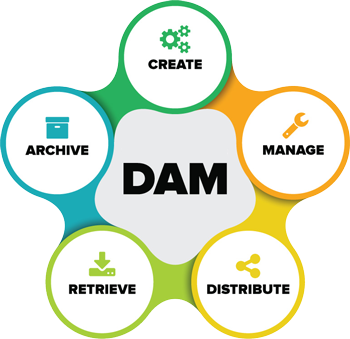Intangible assets like data, brand value, employee knowledge, and cloud storage are as valuable as tangible assets for any company. In some cases, these assets are far more valuable than hard assets like building, equipment, etcetera. Any of these assets that exist in digital form and are accessible digitally are known as digital assets. They are precious for an enterprise even if they seem like just simple, saved files.

Storing, organizing, accessing and maintaining these files is known as digital asset management. DAM (digital asset management) also includes taking care of digital rights and permissions for these files. These files can be anything from simple photos to music files, videos, animations, podcasts or any form of multimedia content. An organization with a robust DAM solution has brand consistency and higher efficiency. With a good DAM system in place, it is easier for organizations to find assets quickly. It reduces the time wastage making them more efficient.
Why use digital asset management system?
The overabundance of digital content is a common problem faced by most of the companies. Storing this content in a way that it is searchable, accessible, usable and secure is of utmost importance for businesses. Here’s how DAM provides all of it and more to make user’s work easier and efficient:
1. Easy & quick search
Files are present everywhere. They are distributed among computer systems and network drives within and outside (clients, partners or agencies) the enterprise. However, when you need a particular file at a specific time, it goes missing. Employees continuously crib about time-wastage when it comes to filing search. DAM takes all the media files and content and stores it centrally. Anyone with the right to access can locate the required file here. This also eliminates the need to transfer files from one employee’s system to another because all the data are centrally available.
2. Requests and approvals
There are so many content requirements and demands a branding team must manage throughout the day. These requirements come from various departments within the organization, press, agencies, partners and clients. The files need to be approved by an authorized person before being sent. A good DAM in place reduces this workload by making relevant data accessible to appropriate teams or departments.
3. Appropriate inventory system
Many institutes, like libraries and museums, use dedicated database applications customized to the type of information they want to store or record. This can be size, location, dates and so on. Likewise, retailers and manufacturers record the information in product- or sector-specific tailored systems. Unfortunately, most of these systems are not able to handle rich-media files like images and videos. Nowadays, most of the content is present in this format only. Marketing and public-relation staff needs such files securely and readily available. Almost all DAM software can handle and manage rich media files with ease.
4. Storing required details
Different organizations have different ways to associate information with files. It can be the name of a celebrity in the image, event, product, client, date, location, color or project. The list of ways to name the file or save it in a particular manner is limitless. To find the file quickly, it’s important to be able to store it by utilizing tags and, then find them using the same tags or description. It is one of the core functionalities of any DAM software.
5. Consistent branding and production values
It is a well-known fact that branding needs to be consistent across all channels. This is the only way audience or clients can recognize or connect with a brand. However, sometimes due to unavailability of the required files, employees end up doing whatever they can with whatever they get. This can result in inconsistencies in marketing communication. Any good Marcom expert values brand consistency and the importance of employees being able to access the right file at the right time. The solution to this problem is to have a commonly existing, organized and maintained media collection that all employees can use appropriately. DAM solution also offers easier and more streamlined ways to work with these files. For example, basic editing, changing the file type, publishing them directly on a company’s social media channels, etc. Having such a solution can improve brand consistency and productivity.
6. Legal liabilities
Every member of the team might not be able to understand the legal consequences of using a random file. Many companies had to pay hefty fines for using files that were not supposed to be used. Most of these weren’t deliberate; they happened due to ignorance of the designer or some other staff member. Therefore, the legal rights associated with the media files that are being used by your employees must be mentioned and understood. In such cases, media library systems along with the DAM can help businesses to avoid such costly errors.
7. Support for media files
Enterprises use content management systems (CMS’s) to maintain websites. Most of the CMS comes with limited search abilities for images. Another common issue with CMS is that most of them automatically resize the images while uploading as per the page template requirement. This sometimes leads to the destruction of the master file. Some CMS delete metadata file, which might include copyright or other such information.
Digital asset management software types
There are multiple types of DAM software systems. A company must choose the software as per its requirement. Here are more details about these DAM solutions to help you understand better:
1. Brand asset management systems
This DAM solution is chiefly focused on helping marketing teams. The key purpose of this type of software is to securely manage all the branding assets like videos, logos, images, animations, etc. reliably.
2. Library asset management systems
This DAM solution focuses on organizing and maintaining a large amount of infrequently changing digital assets. This includes searching, storing and retrieving these assets wherever and whenever required.
3. Production asset management systems
This DAM solution emphases on storing, organizing and reviewing control of frequently changing digital assets.
4. Digital supply chain services
This DAM solution is used for the distribution of content to digital retailers.
Selecting Right DAM System
Now when you have gained all the information about digital asset management systems, it’s time to choose the right one for your organization. A good DAM solution can be tailored as per the company’s requirement. Still, here are some basic features that you must check before getting a DAM solution:
1. Flexibility and Adaptability
Any digital asset management system must support flexible metadata schemes. User should be able to modify labels and fields as per their needs and suitability. This will enable intuitive search and retrieval of assets.
It must allow an administrator to configure the system in such a way that a user sees only the features they need to use and assets they are supposed to access to do their job. This will result in enhanced productivity, lower stress and a clutter-free work environment.
2. Collaboration
Collaboration is one of the critical characteristics of any successful team. DAM software also needs to have tools and features that can help your team to work together even more efficiently. This feature could be as simple as chat among the team members, ability to approve or disapprove someone’s work, schedule tasks or leave notes for your teammates.
3. Distribution
The ability to distribute the assets quickly and easily to various platforms like email, social media channels, etc. is beneficial in certain situations. This feature is essential for your business if you need digital assets to be shared across channels.
4. Analytics
It’s important to keep track of assets being uploaded, downloaded, used, accessed and shared. You might need the answers to questions like what is being published? What needs modification? What has been used mostly? A good DAM solution should be able to provide a wide range of measurement and reports.
Integrating digital asset management (DAM) system into your business is a decision that will have a substantial impact on marketing strategies. It will improve collaboration among different teams, simplify asset searching for everyone and automate manual tasks.



Comments
I just could not leave your web site before suggesting that I really loved the standard info a person provide on your visitors? Is gonna be again often in order to investigate cross-check new posts
Author
Thanks for your feedback. Keep visiting Us.
Hi there! This is my first visit to your blog! We are a collection of volunteers and starting a new initiative in a community in the same niche. Your blog provided us beneficial information to work on. You have done a outstanding job!
Author
Thanks for your feedback. Keep visiting Us.
I’m grateful for having you as a friend!
Author
Thanks my friend.